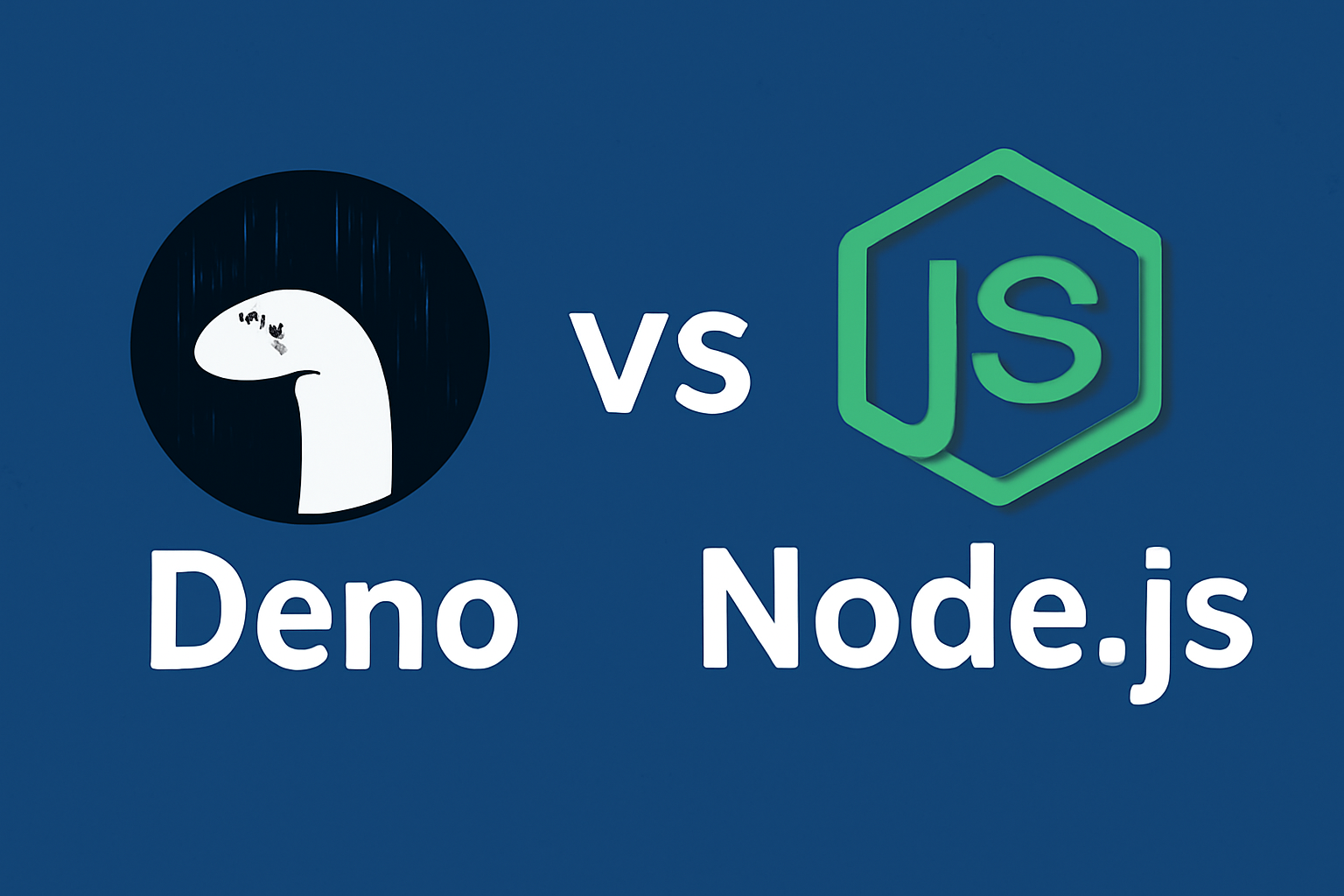In the constantly evolving landscape of JavaScript runtime environments, two names have sparked considerable discussion among developers, architects, and technologists alike: Deno and Node.js. Both serve as powerful tools for building server-side and networked applications using JavaScript — but they represent two distinct philosophies and approaches toward executing JavaScript outside the browser – Deno vs. Node.js.
The journey from Node.js to Deno is not merely an update in technology but a reflection of lessons learned, new priorities, and a fresh perspective on what a runtime environment should offer in 2025 and beyond.
This article explores Deno vs. Node.js in depth, dissecting their origins, core differences, technical architectures, security models, ecosystem maturity, and real-world applicability. Whether you’re a seasoned backend developer, a tech decision-maker, or simply curious about the future of JavaScript runtimes, this comparative analysis will provide fresh, insightful, and comprehensive information to help you navigate the choice between these two influential platforms.
Understanding Node.js: The Pioneer of JavaScript on the Server
To appreciate the emergence of Deno, it is crucial to understand the foundational impact of Node.js.
What is Node.js?
Launched in 2009 by Ryan Dahl, Node.js transformed the JavaScript landscape by allowing JavaScript to run on the server side, outside of web browsers. Built on Google’s V8 JavaScript engine, Node.js brought asynchronous, event-driven programming to server development — enabling high concurrency and efficient handling of I/O operations.
The Node.js Philosophy
Node.js embraced simplicity and practicality. It prioritized fast development cycles, a vast package ecosystem (via npm), and non-blocking I/O. This made Node.js ideal for scalable network applications, APIs, and microservices.
The Ecosystem and Popularity
Node.js quickly became a dominant runtime environment, powering everything from startups to enterprise solutions. Its npm package manager grew to become the world’s largest software registry, boasting millions of reusable modules.
However, Node.js was not without challenges, some of which surfaced over the years:
- Security vulnerabilities due to default access to the file system and network.
- Complexities arising from callback-heavy asynchronous programming (though addressed with Promises and async/await).
- Legacy design decisions limiting modern development practices.
- A monolithic core API, which became hard to maintain as the runtime grew.
Ryan Dahl himself later reflected on these issues and saw an opportunity to rethink the architecture altogether, which led to the birth of Deno.
Enter Deno: A New JavaScript Runtime Reimagined
Origins and Motivation
In 2018, Ryan Dahl introduced Deno, a modern runtime environment designed to address many of the shortcomings he identified in Node.js. His goal was clear: create a secure, productive, and reliable runtime with built-in support for TypeScript and a fresh approach to package management.
Core Principles Behind Deno
- Secure by Default: No file, network, or environment access unless explicitly enabled.
- First-Class TypeScript Support: Run TypeScript out-of-the-box without additional tooling.
- Simplified Module System: No centralized package manager; instead, use URL-based imports.
- Modern API Design: Uses modern JavaScript features and a promise-based API.
- Built-in Utilities: Comes bundled with a linter, formatter, test runner, and more.
Technical Architecture
Deno is built on the V8 engine, like Node.js, but uses Rust for its core implementation, which enhances safety and performance. Its design integrates the Tokio asynchronous runtime (from Rust) for efficient concurrency.
Key Differences Between Deno and Node.js
1. Security
Perhaps the most striking difference is how the two handle security.
- Node.js: By default, Node.js programs have unrestricted access to the file system, network, and environment variables. Developers must manually implement security safeguards.
- Deno: Embraces a sandbox model. Permissions must be granted explicitly via command-line flags (e.g.,
--allow-read,--allow-net). This “secure by default” approach reduces the attack surface and fosters safer code.
2. Module and Package Management
- Node.js: Uses npm, the world’s largest package repository. Developers manage dependencies through
package.jsonandnode_modules. This system is mature but sometimes criticized for bloated dependency trees and “dependency hell.” - Deno: Eschews npm entirely. It loads modules directly from URLs or local files, similar to browser JavaScript modules. This means no centralized package manager or
node_modules. Developers benefit from simplicity but may face challenges in dependency management and caching.
3. Language Support
- Node.js: Supports JavaScript natively and added TypeScript support through third-party transpilers or additional build steps.
- Deno: Built with first-class TypeScript support, allowing seamless execution without extra configuration. This is a huge boon for developers leveraging TypeScript’s static typing.
4. Standard Library and APIs
- Node.js: Has a large built-in API for file system, networking, cryptography, streams, etc., which sometimes suffer from legacy inconsistencies.
- Deno: Provides a modern standard library with promise-based APIs that align with browser standards, encouraging consistent development patterns across platforms.
5. Tooling and Developer Experience
- Node.js: Requires a collection of third-party tools for linting, formatting, and testing. This flexibility allows tailored workflows but can complicate onboarding.
- Deno: Ships with built-in tooling such as a linter (
deno lint), formatter (deno fmt), test runner (deno test), and bundler. These are accessible out-of-the-box, reducing setup time and improving productivity.
6. Community and Ecosystem Maturity
- Node.js: Boasts a vast, mature ecosystem with millions of modules, extensive documentation, and widespread adoption across industries.
- Deno: While rapidly growing, its ecosystem is nascent compared to Node.js. Some modules and third-party integrations are still under development.
Practical Considerations: When to Use Deno vs. Node.js
Choosing between Deno and Node.js depends on various factors — project requirements, team expertise, performance needs, and long-term maintainability – Deno vs. Node.js.
Use Cases Favoring Node.js
- Legacy projects already built on Node.js.
- Projects requiring specific npm packages that do not yet have Deno equivalents.
- Large teams familiar with Node.js workflows.
- Production environments relying on stable, battle-tested platforms.
- Use cases demanding extensive third-party tooling and integrations.
Use Cases Favoring Deno
- New projects requiring a secure-by-default environment.
- Applications heavily reliant on TypeScript.
- Developers who prefer modern ES modules over CommonJS.
- Projects that benefit from built-in tooling and simplified dependency management.
- Experimental or greenfield projects where long-term maintainability and modern best practices are prioritized.
Performance: How Do Deno and Node.js Compare?
Performance benchmarks vary depending on use cases, but both runtimes leverage the V8 engine, ensuring competitive JavaScript execution speed.
- Startup time: Deno’s startup is typically slower due to security checks and module fetching, but caching improves subsequent runs.
- Throughput: Node.js maintains an edge in certain I/O heavy applications due to optimizations accumulated over years.
- Memory usage: Deno, written in Rust, is more memory efficient in some scenarios.
Overall, for most typical backend workloads, the performance differences are marginal and overshadowed by architectural and security considerations.
Developer Experience: A Closer Look
Error Handling and Debugging
Both runtimes support source maps and debugging tools. Deno’s strict permission model prevents many runtime errors related to unauthorized access, enhancing debugging clarity.
Code Style and Standards
Deno encourages ES module usage and modern JavaScript features by default, which promotes cleaner and more future-proof code. Node.js developers may need additional configuration to adopt these patterns fully.
Security: The Game Changer
Deno’s sandboxing approach addresses a critical gap in Node.js’ security posture. Many high-profile breaches in Node.js applications stem from inadvertent file or network access. By requiring explicit permission grants, Deno mitigates risks at runtime, encouraging developers to think carefully about their app’s access scope.
Ecosystem and Community: The Network Effect
Node.js benefits from a vast, diverse community and extensive enterprise backing (by companies like Microsoft, IBM, and PayPal). This ensures robust support, frequent updates, and a rich ecosystem.
Deno is younger but growing steadily, backed by strong advocacy from its creator and a dedicated community. Its modern approach is attracting developers interested in secure, TypeScript-first development.
Looking Ahead: The Future of JavaScript Runtimes
The future will likely see both runtimes coexisting and evolving. Node.js will continue to serve as the backbone of many legacy and enterprise systems, while Deno pushes forward modern standards, security, and developer experience.
Integration efforts are already underway, with tools allowing Node.js compatibility layers in Deno and efforts to bridge ecosystems.
Conclusion: Making the Right Choice
The Deno vs. Node.js debate is not about one being superior universally, but about understanding your needs, constraints, and goals.
- Node.js remains a proven, powerful platform with an unmatched ecosystem.
- Deno offers a fresh, secure, and modern take on server-side JavaScript, promising improved developer experience and safety.
For developers and organizations charting their JavaScript runtime path, this analysis should serve as a foundation for informed decisions, balancing innovation with reliability.
Read:
Understanding JavaScript Data Types and Variables
30 Interview Questions on JavaScript: A Comprehensive Guide for Aspiring Developers
JavaScript Control Flow: Using If Statements, Loops, and Switch Cases
FAQs
1. What are the main security differences between Deno and Node.js?
Answer: Deno is secure by default, requiring explicit permission to access files, network, and environment variables, whereas Node.js provides unrestricted access by default, placing the responsibility for security on the developer.
2. Does Deno replace npm for package management?
Answer: No, Deno does not use npm. Instead, it loads modules directly from URLs or local files without a centralized package manager, simplifying dependency management but requiring a different workflow than Node.js.
3. Can I run TypeScript natively on both Deno and Node.js?
Answer: Deno has built-in first-class support for TypeScript and runs it out-of-the-box. Node.js requires additional tooling or transpilers to run TypeScript code.
4. Which runtime has better tooling support out-of-the-box?
Answer: Deno includes built-in tools like a linter, formatter, test runner, and bundler, reducing setup complexity. Node.js typically relies on third-party tools for these functionalities.
5. Is the performance of Deno better than Node.js?
Answer: Both runtimes are fast, leveraging the V8 engine. Node.js tends to have faster startup times and slightly better throughput in some scenarios, while Deno offers memory efficiency and modern concurrency models. Performance differences are generally small.











